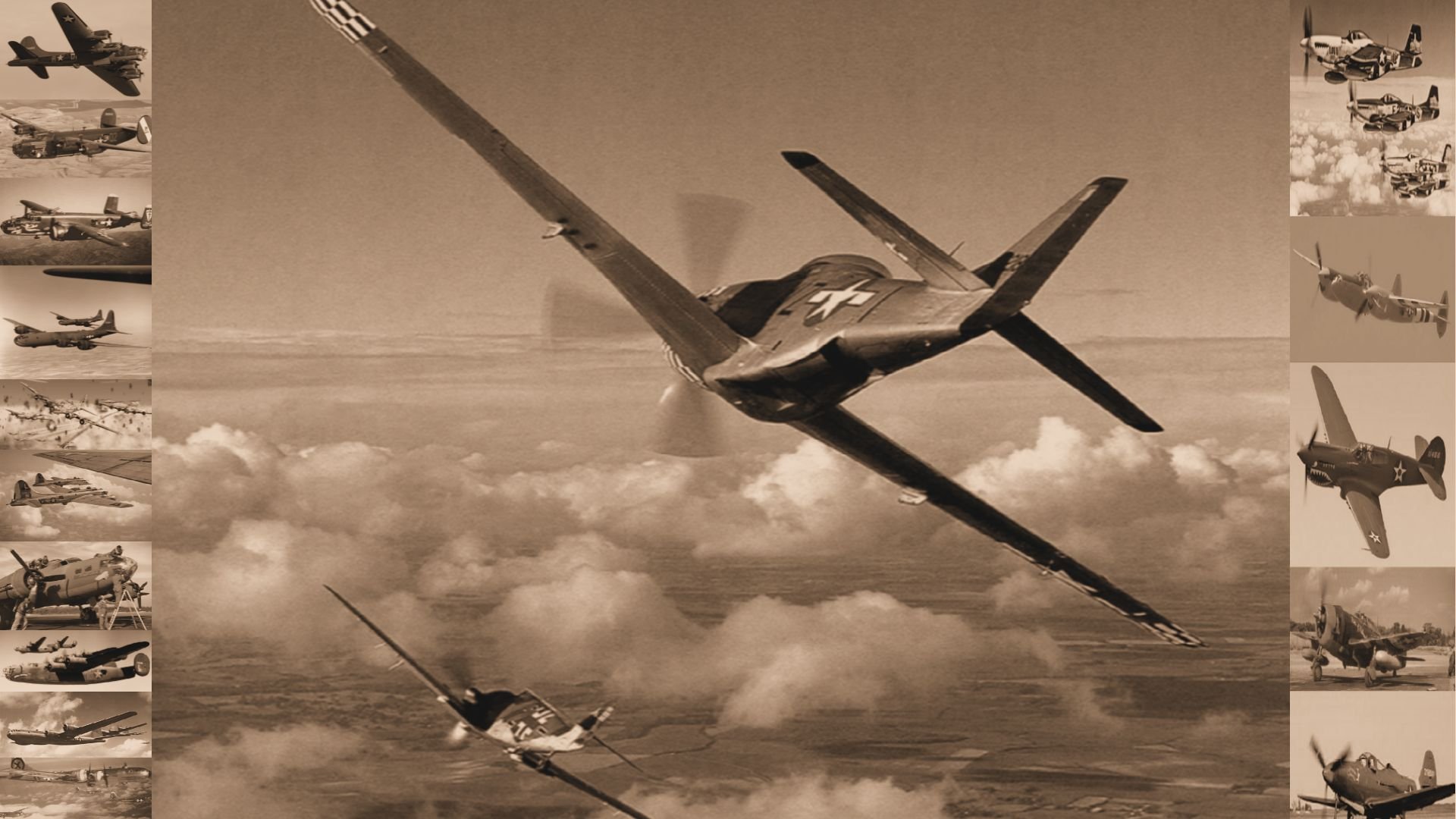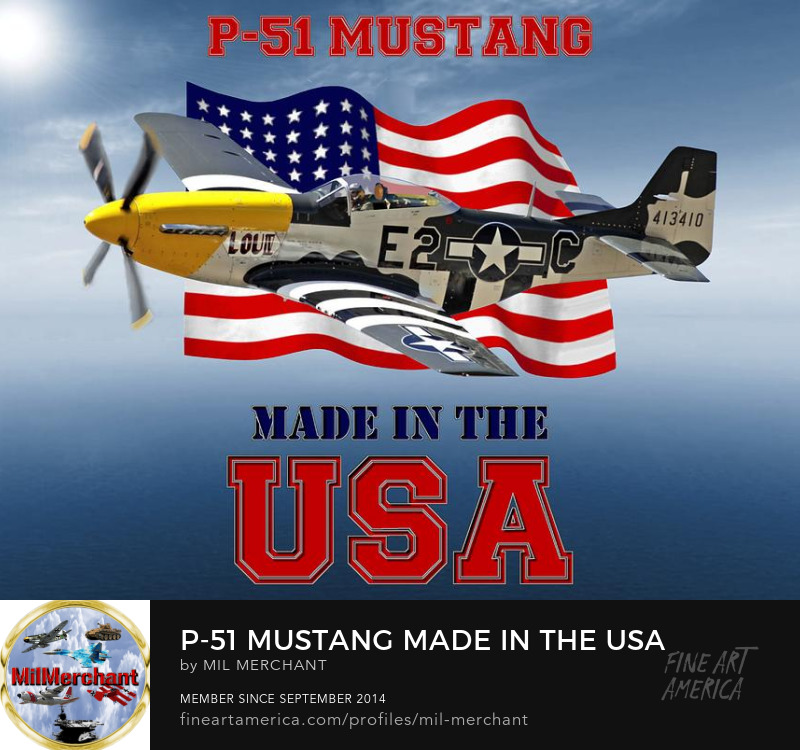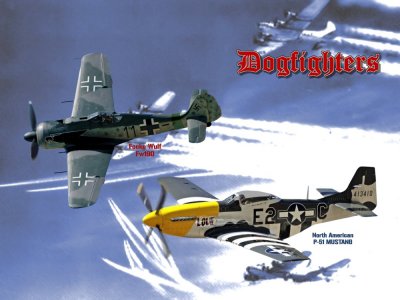The North American Aviation(NAA) P-51 'Mustang' was an American long-range, single-seat fighter and fighter-bomber used during World War II, the Korean War and other conflicts. The Mustang was conceived, designed and built by North American Aviation (NAA) in response to a specification issued directly to NAA by the British Purchasing Commission. The prototype NA-73X airframe was rolled out on 9 September 1940, 102 days after the contract was signed and, with an engine installed, first flew on 26 October 1941.
Back to Top
Development
The Mustang was originally designed to use the Allison V-1710 engine, which had limited high-altitude performance. It was first flown operationally by the Royal Air Force (RAF) as a tactical-reconnaissance aircraft and fighter-bomber (Mustang Mk I). The addition of the Rolls-Royce Merlin to the P-51B/C model transformed the Mustang's performance at altitudes above 15,000 ft, giving it a performance that matched or bettered the majority of the Luftwaffe's fighters at altitude. The definitive version, the P-51D, was powered by the Packard V-1650-7, a license-built version of the Rolls-Royce Merlin 60 series two-stage two-speed supercharged engine, and armed with six .50 caliber (12.7 mm) M2 Browning machine guns.
Back to Top
Variants
A-36 Apache/Invader
On 16 April 1942, Fighter Project Officer Benjamin S. Kelsey ordered 500 A-36 Apaches, a redesign that included six .50 in (12.7 mm) M2 Browning machine guns, dive brakes, and the ability to carry two 500 lb (230 kg) bombs. Kelsey would rather have bought more fighters but was willing instead to initiate a higher level of Mustang production at North American by using United States Army Air Corps(USAAC) funds earmarked for ground-attack aircraft when pursuit aircraft funding had already been allocated. On 23 June 1942, a contract was placed for 1,200 P-51As (NA-99s). The P-51A used the new Allison V-1710-81 engine, a development of the V-1710-39, driving a 10 ft 9 in (3.28 m) diameter three-bladed Curtiss-Electric propeller. The armament was changed to four wing-mounted .50 in (12.7 mm) Browning machine guns, two in each wing, with a maximum of 350 rounds per gun (rpg) for the inboard guns and 280 rpg for the outboard. Other improvements were made in parallel with the A-36, including an improved, fixed air duct inlet replacing the movable fitting of previous Mustang models and the fitting of wing racks able to carry either 75 or 150 U.S. gal (284 or 568 l) drop tanks, increasing the maximum ferry range to 2,740 mi (4,410 km) with the 150 gal (568 l) tanks. The top speed was raised to 409 mph (658 km/h) at 10,000 ft (3,000 m). A total of 50 aircraft were shipped to England, serving as Mustang Mk IIs in the RAF. The 500 were designated A-36A((NA-97)Apache). This model became the first USAAF Mustang to see combat. One aircraft (EW998) was passed to the British who gave it the name Mustang Mk I (Dive Bomber).
Back to Top
P-51B and P-51C
It was decided that new P-51B (NA-102) would continue with the four wing-mounted .50 in (12.7 mm) M2/AN Browning machine guns (with 350 rpg for the inboard guns and 280 rpg for the outboard) first used in the P-51A, while the bomb rack/external drop tank installation was adapted from the A-36 Apache. P-51Bs and P-51Cs started to arrive in England in August and October 1943. The P-51B/P-51C versions were sent to 15 fighter groups that were part of the 8th and 9th Air Forces in England and the 12th and 15th in Italy (the southern part of Italy was under Allied control by late 1943). Other deployments included the China Burma India Theater (CBI).
Back to Top
P-51D and P-51K
The P-51D became the most widely produced variant of the Mustang. During 1945-48, P-51Ds were also built under licence in Australia by the Commonwealth Aircraft Corporation. A Dallas-built version of the P-51D, designated the P-51K, was equipped with an 11 ft (3.4 m) diameter Aeroproducts propeller in place of the 11.2 ft (3.4 m) Hamilton Standard propeller. As well as the modified fuselage and new canopy the production P-51Ds had modified wings compared with the P-51B/C series and became the most widely produced variant of the Mustang, with 6,502 being built at Inglewood and 1,600 at Dallas - a combined total of 8,102. 280 were used by the RAF and designated Mustang Mk IV. These aircraft had the 'Malcolm Hood' canopy giving a much better view, to which the design was incorporated into the P-51C.
Back to Top
Into Service
USAAC
From late 1943, P-51Bs (supplemented by P-51Ds from mid-1944) were used by the USAAF's Eighth Air Force to escort bombers in raids over Germany, while the RAF's 2 TAF and the USAAF's Ninth Air Force used the Merlin-powered Mustangs as fighter-bombers, roles in which the Mustang helped ensure Allied air superiority in 1944. The Luftwaffe's twin-engine heavy fighters brought up to deal with the bombers proved to be easy prey for the Mustangs and had to be quickly withdrawn from combat. The Focke-Wulf Fw190A, already suffering from poor high-altitude performance, was no match for the Mustang at the B-17's altitude, and when laden with heavy bomber-hunting weapons as a replacement for the more vulnerable twin-engined Bf110 and Me410 Zerstörer heavy fighters, it suffered badly. The Messerschmitt Bf109G was on a more even footing at high altitudes, but this lightweight platform was even more greatly affected by increases in armament. The Mustang's much lighter armament, tuned for anti-fighter combat, allowed them to hunt down both of these fighters with relative ease. Enough P-51s became available to the 8th and 9th Air Forces in the winter of 1943-44. When the Pointblank offensive resumed in early 1944, matters had changed dramatically. The defence was initially layered, using the shorter range P-38s and P-47s to escort the bombers during the initial stages of the raid and then handing over to the P-51 when they turned for home. This provided continual coverage during the entire raid. The Mustang was so clearly superior to earlier US designs that the Eighth Air Force began to switch its fighter groups to the Mustang, first exchanging arriving P-47 groups for those of the 9th Air Force using P-51s, then gradually converting its Thunderbolt and Lightning groups. By the end of 1944, 14 of its 15 groups flew the P-51. The P-51 was also in service with Allied air forces in North Africa, the Mediterranean and Italian campaigns, serving with distinction in the 332nd Fighter Group, the 'Tuskegee Airmen', China, Burma and saw service against the Japanese, escorting B-29's from Onkinawa and conducting fighter sweeps over Japan at the end of the Pacific War. The P-51 Mustang was a solution to the clear need for an effective bomber escort. The Mustang was at least as simple as other aircraft of its era. It used a common, reliable engine and had internal space for a huge fuel load. With external fuel tanks, it could accompany the bombers all the way to Germany and back. During World War II, Mustang pilots claimed 4,950 enemy aircraft shot down.
Back to Top
CBI and the Pacific
In early 1945, P-51C, D, and K variants also joined the Chinese Nationalist Air Force. These Mustangs were provided to the 3rd, 4th, and 5th Fighter Groups and used to attack Japanese targets in occupied areas of China. The P-51 became the most capable fighter in China, while the Imperial Japanese Army Air Force used the Nakajima Ki-84 'Hayate' against it. The P-51 was a relative latecomer to the Pacific Theater, due largely to the need for the aircraft in Europe, although the P-38's twin-engined design was considered a safety advantage for long, over-water flights. The first P-51s were deployed in the Far East later in 1944, operating in close-support and escort missions, as well as tactical photo-reconnaissance. As the war in Europe wound down, the P-51 became more common. With the capture of Iwo Jima, USAAF P-51 Mustang fighters of the VII Fighter Command were stationed on that island starting in March 1945, being initially tasked with escorting Boeing B-29 Superfortress missions against the Japanese homeland.
Back to Top
RAF
The Mustang was initially developed for the RAF, which was its first user. As the first Mustangs were built to British requirements, these aircraft used factory numbers and were not P-51s; the order comprised 320 NA-73s, followed by 300 NA-83s, all of which were designated North American Mustang Mark I by the RAF. The first RAF Mustangs supplied under Lend-Lease were 93 P-51s, designated Mk Ia, followed by 50 P-51As used as Mustang Mk IIs. After the arrival of the initial aircraft in the UK in October 1941, the first squadron of Mustang Mk Is entered service in January 1942, the first being No. 26 Squadron RAF. Due to poor high-altitude performance, the Mustangs were used by Army Co-operation Command, rather than Fighter Command, and were used for tactical reconnaissance and ground-attack duties. On 10 May 1942, Mustangs first flew over France, near Berck-sur-Mer. On 27 July 1942, 16 RAF Mustangs undertook their first long-range reconnaissance mission over Germany. During the amphibious Dieppe Raid on the French coast (19 August 1942), four British and Canadian Mustang squadrons, including 26 Squadron, saw action covering the assault on the ground. By 1943-1944, British Mustangs were used extensively to seek out V-1 flying bomb sites. The last RAF Mustang Mk I and Mustang Mk II aircraft were struck off charge in 1945.
Back to Top
Post World War 2
At the start of Korean War, the Mustang was the main fighter of the United Nations until jet fighters such as the F-86 took over this role, then the P-51 Mustang became a specialized fighter-bomber. Despite the advent of jet fighters, the Mustang remained in service with a number of Air Forces until the early 1980s. After World War II and the Korean War, many Mustangs were converted for civilian use, especially air racing and increasingly, preserved and flown as an historic warbird aircraft at airshows. Over 50 countries used the P-51 well into the 1960's, with some even used till 1980. It fought in Korea, Israel and the Dominican Republic(where the last P-51 was shot down during operations in 1965) just to name some of the major conflicts since World War 2 that this plane has participated in. The last U.S. military use of the F-51 (redesignated 'F' in 1947) was in 1968, when the U. S. Army employed a vintage F-51D (44-72990) as a chase aircraft for the Lockheed YAH-56 Cheyenne armed helicopter project. Overall, some 15,000 P-51 in all variants were produced with over 200 still operational, owned by private pilots around the world, with many more in museums worldwide.
Back to Top





